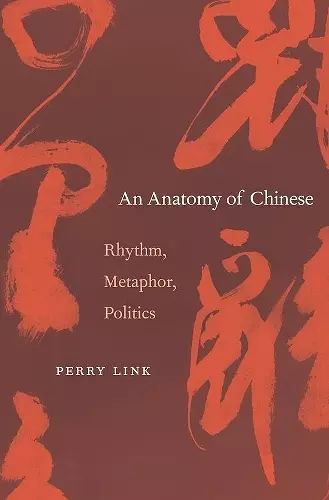An Anatomy of Chinese
Rhythm, Metaphor, Politics
Format:Hardback
Publisher:Harvard University Press
Published:17th Mar '13
Currently unavailable, and unfortunately no date known when it will be back

In An Anatomy of Chinese, Perry Link has made a fascinating discovery that those who are literate in Chinese are subliminally aware of, but which he is the first to make explicit in a lucid and illuminating fashion. Link brings aspects of the Chinese language-innate cadences, prosody-to the surface and analyzes them in such a fashion that we come to understand the structure and genius of Chinese better than ever before. It is a captivating and ingenious tale that the author spins. -- Victor Mair, University of Pennsylvania
Rhythms, conceptual metaphors, and political language convey meanings of which Chinese speakers themselves may not be aware. Link’s Anatomy of Chinese contributes to the debate over whether language shapes thought or vice versa, and its comparison of English with Chinese lends support to theories that locate the origins of language in the brain.
During the Cultural Revolution, Mao exhorted the Chinese people to “smash the four olds”: old customs, old culture, old habits, and old ideas. Yet when the Red Guards in Tiananmen Square chanted “We want to see Chairman Mao,” they unknowingly used a classical rhythm that dates back to the Han period and is the very embodiment of the four olds. An Anatomy of Chinese reveals how rhythms, conceptual metaphors, and political language convey time-honored meanings of which Chinese speakers themselves may not be consciously aware, and contributes to the ongoing debate over whether language shapes thought, or vice versa.
Perry Link’s inquiry into the workings of Chinese reveals convergences and divergences with English, most strikingly in the area of conceptual metaphor. Different spatial metaphors for consciousness, for instance, mean that English speakers wake up while speakers of Chinese wake across. Other underlying metaphors in the two languages are similar, lending support to theories that locate the origins of language in the brain. The distinction between daily-life language and official language has been unusually significant in contemporary China, and Link explores how ordinary citizens learn to play language games, artfully wielding officialese to advance their interests or defend themselves from others.
Particularly provocative is Link’s consideration of how Indo-European languages, with their preference for abstract nouns, generate philosophical puzzles that Chinese, with its preference for verbs, avoids. The mind-body problem that has plagued Western culture may be fundamentally less problematic for speakers of Chinese.
Perry Link's An Anatomy of Chinese is original, superbly informed by living experience, full of stimulating (and sometimes challenging) insights, nourished by a deep understanding of contemporary Chinese realities. It should become recommended reading for any person who is involved with China—scholars, students, visitors, residents—and, more broadly, for all civilized individuals who feel a need to complete their own humanity by getting better acquainted with the Chinese perspective. -- Simon Leys, author of The Hall of Uselessness
The most significant scholarly work in recent decades that uncovers the repressed nuances and rhythms of the Chinese language. Only Perry Link can give meaning and power so magnificently to Chinese clichés and linguistic routines. High-brow and low-brow Chinese words and syntaxes, the unacquainted speaking patterns and metaphorical structures of the East and West have finally found each other in a brilliant, first-rate comparative analysis by America's preeminent authority on contemporary Chinese language. -- Maochun Yu, United States Naval Academy
Perry Link's book is the first comprehensive study, in either English or Chinese, on language and politics in China. With an incredible ear for subtle twists and turns in verbal expressions, Link examines the impact of rhythm and metaphor on the rhetoric of slogans, enhancing our understanding of linguistic mechanisms that account for the power of slogans in communist politics and illustrating with a wealth of examples the intricate interactions between sound and structure in spoken Chinese. -- Pang-Hsin Ting, University of California, Berkeley
Perry Link's An Anatomy of Chinese is a rich, delightfully refreshing and satisfying look at features of Chinese language rarely probed in standard accounts -- a feast of insights from start to finish. -- Chad Hansen, University of Hong Kong
In An Anatomy of Chinese, Perry Link has made a fascinating discovery that those who are literate in Chinese are subliminally aware of, but which he is the first to make explicit in a lucid and illuminating fashion. Link brings aspects of the Chinese language—innate cadences, prosody—to the surface and analyzes them in such a fashion that we come to understand the structure and genius of Chinese better than ever before. It is a captivating and ingenious tale that the author spins. -- Victor Mair, University of Pennsylvania
Link's fascinating tour de force makes clear the many ways in which the rhythms and metaphors of written and spoken Chinese contribute to Chinese cultural formation, individual character formation and political manipulation. Insisting on using familiar terms in place of jargon, Link makes linguistics accessible and even fun for all of us. -- Michael S. Duke, author of The Iron House: A Memoir of the Chinese Democracy Movement and the Tiananmen Massacre
- Nominated for Joseph Levenson Book Prize 2015
ISBN: 9780674066021
Dimensions: unknown
Weight: unknown
376 pages